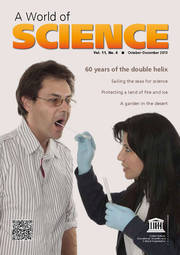Vol 7 N° 3 [July–September 2009]
CONTENTS
IN FOCUS
2 Mission to Mars
NEWS
11 Disaster risk on the rise, says UN report
11 Twenty-two new biosphere reserves
13 Cape Verde joins virtual campus network
13 A digital library for the world
14 World Atlas of Great Apes now in French
INTERVIEW
15 Claudio Tuniz traces human migration out of Africa
HORIZONS
18 Learning to live with drought in Europe
21 A pinch of salt
IN BRIEF
24 Diary
24 New releases
Direct link A World of Science Vol. 7 n°3 (document PDF)
See also ARCHIVES for A World of Science
EDITORIAL
We walked on the Moon
On 20 July, it will be 40 years since human beings walked on the Moon. Incredibly, this exploit may well be surpassed this century: NASA is making tentative plans to establish an international base on Mars within the next 30 years or so. This means that our children may not only live to see images of people walking on Mars; some of them may even be crew members! It is thus with our younger readers in mind that we have imagined the scenario in this issue for a Mission to Mars.
Forty years after we walked on the Moon, another landmark in human endeavour is being celebrated this year. On 24 November 1859, Charles Darwin published On the Origin of Species. This work introduced the theory that species evolve over the course of generations through a process of natural selection which favours certain traits over others to give an organism a better chance of surviving long enough to reproduce. Over the past 150 years, evidence accumulated from palaeontology, evolutionary biology, microbial genetics, molecular genetics, embryology, anatomy and other scientific disciplines has systematically corroborated the theory of evolution.
Evidence of evolution has even come from an unexpected quarter: nuclear physics. Claudio Tuniz from UNESCO’s Abdus Salam International Centre for Theoretical Physics explains in these pages how new chronometers and x-ray microscopes developed through research in basic physics are helping to trace human evolution and dispersal over the past two million years.
It has been said that On the Origin of Species dealt one of two stunning blows to humanity’s self-image, the other being Nicolaus Copernicus’ theory On the Revolutions of the Celestial Spheres, which explained that the Sun was the centre of our Solar System and not the Earth. Theological resistance at the time was so strong that Copernicus waited until he was on his deathbed to publish his theory in 1543.
When Neil Armstrong set foot on the Moon, he said, ‘This is a small step for a man, a giant leap for mankind.’ Copernicus and Darwin could have uttered those very same words as they handed over their manuscripts to the publisher. One small step on their part and humankind took a giant leap forward. Thanks to them, schoolchildren the world over know who they are, where they come from and where they live. ‘Scientific thought is the common heritage of humankind,’ Nobel Laureate Abdus Salam used to say.
W. Erdelen
Assistant Director-General for Natural Sciences

